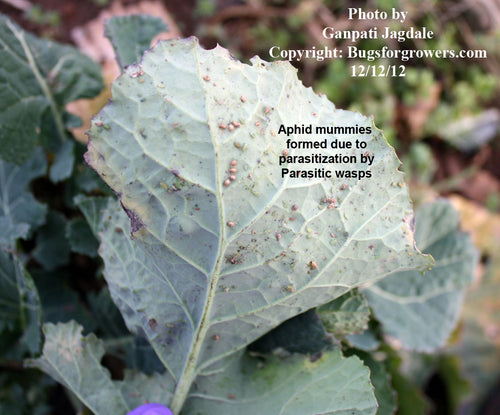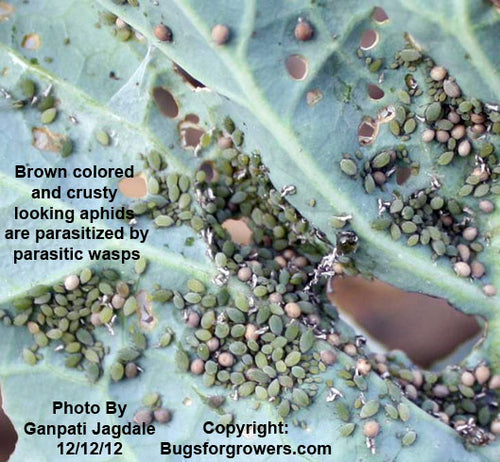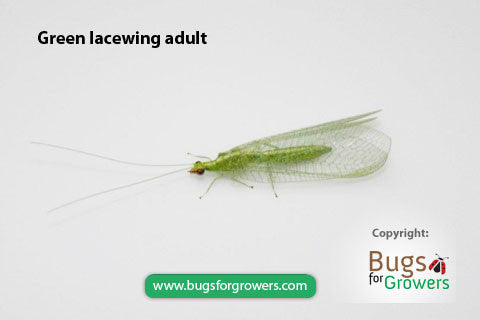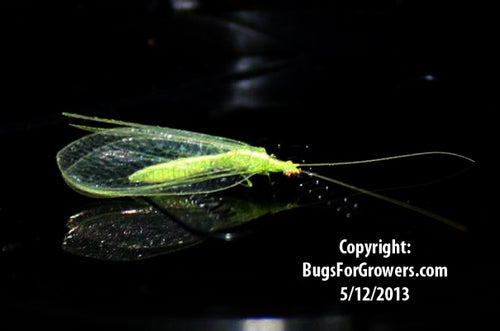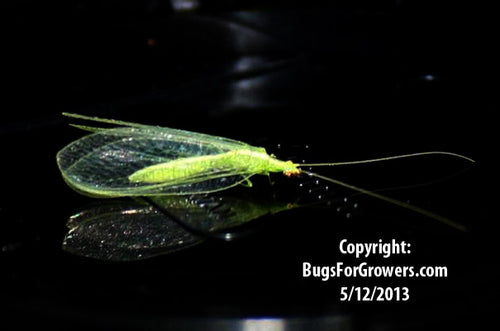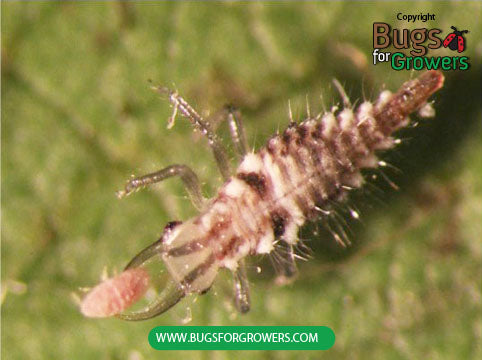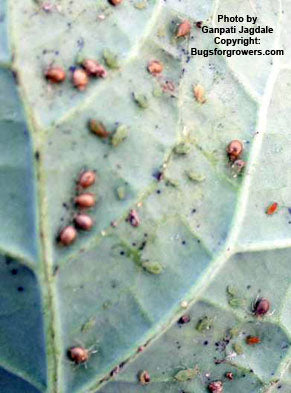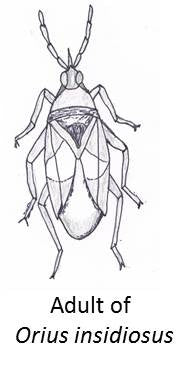Aphids
Importance of Aphids
Aphids are also called as plant lice and considered as polyphagous feeders because they munch on several species of ornamental plants, field crops, vegetables, fruits, weeds, grasses, and greenhouse, polyhouse, indoor and nursery plants (Photo 1. Aphid Colony). There are over 4000 species of aphids have already been described from all over the world and responsible for causing a tremendous economic loss to agricultural and horticultural industries.
Watch following video about types of damages caused by aphids to crops.

Facts (show all)
- Taxonomy and list of the most economically devastating species of Aphids
-
- Common and Scientific names: Alfalfa aphid (Acyrthosiphon pisum), Bean aphid (Aphis fabae), Bird cherry-oat aphid (Rhopalosiphum padi), Black Cherry aphid (Myzus ceraki), Cabbage aphid (Brevicoryne brassicae), California Laurel aphid (Euthoracaphis umbellulariae), Cereal aphid (Sitobion avenae), Cotton aphid (Aphis gossypii), Glasshouse potato aphid (Aulacorthum solani), Green apple aphid (Aphis pomi), Green peach aphid (Myzus persicae),Leaf curl plum aphid (Brachycaudus helichrysi), Mealy plum aphid (Hyalopterus pruni), Melon aphid (Aphis gossypii), Pea aphid (Acyrthosiphon pisum), Potato aphid (Macrosiphum euphorbiae), Rose aphid (Macrosiphum rosae), Rosy apple aphid (Dysaphis plantaginea), Sunflower aphid (Aphis helianthi), Tobacco aphid (Myzus nicotianae), Tulip bulb aphid (Dysaphis tulipae), Woolly apple aphid (Eriosoma lanigerum), Willow-carrot aphid (Caveriella aegopodii)
- Kingdom: Animalia
- Phylum: Arthropoda
- Class: Insecta
- Order: Hemiptera
- Suborder: Sternorrhyncha
- Family: Aphididae
- Subfamily: Aphidoidea
- Genus: Several different genera (see above)
- Species: Several different species (see above)
- Identification of Aphids
-
Adult Aphids: Aphids are tiny 1 to 10 mm long, pear-shaped, soft-bodied insects. Depending on the species, they can be black, brown, green, pink, or red in color. Adults have long antennae and legs. They can be with wings or without wings. The wingless aphids are more predominant than the winged adults. Winged aphids are generally formed when a chemical cue is triggered due to crowding in a wingless aphid colony. These winged aphids generally fly away from a crowed colony in search of new un-infested or secondary host plants on which they can start a new colony. Adult aphids have piercing and sucking types of moth parts. Unlike other species of insects, aphids have two characteristic cornicles (tubular structures) projecting backward out of posterior end of their body. Aphids generally use these cornicles for the excretion of defensive fluids.
Eggs: Only some species of aphids lay oval shaped eggs as an overwintering strategy.
Nymphs: Baby aphids are called nymphs. Nymphs look like their parents. Nymphs can be black, brown, green, pink, or red in color depending on the species. Like parents, nymphs also have piercing and sucking types of moth parts and cornicles at their posterior end of the body.
Pupae: There is no pupal stage in the life cycle of aphids.
- Biology of Aphids
-
The life cycle of aphids also consists of egg (only some species of aphids lay eggs), nymphal and adult stages but not the pupal stage. With some exceptions, almost all the species of aphids reproduce asexually that is without mating. Asexually reproducing aphids generally give direct birth to offspring and produce multiple generations in a year. However, some of these asexually reproducing species of aphids produce sexually at least one generation of individuals that commonly lay eggs during fall as an overwintering stage. In the spring when temperature warms up, these overwintering eggs hatch into tiny nymphs that immediately start feeding on different plant parts. While feeding, nymphs develop through 4 stages and become adults. Adult aphids then continue to reproduce multiple generations asexually throughout the year.
- What type of damage is caused by aphids?
-
Aphids cause both direct and indirect damage to their host plants. In case of direct damage, both adults and nymphs of aphids use their piercing and sucking types of mouthparts to suck cell sap (juice) from all the tender plant parts including buds, flowers stems and leaves. The voracious feeding by a high population of aphids can cause yellowing and curling of infested leaves and seriously weakens plant growth, which in turn can reduce the crop yields. In case of indirect damage, honeydew secreted by aphids during feeding stimulates the growth of black sooty mold on the surface of leaves. This black sooty mold generally covers whole leaf area and badly affects the photosynthesis, a process used by plants to convert light energy from sun to chemical energy for the synthesis of their own food including carbohydrates and proteins. This black sooty mold also reduces the quality of the produce and aesthetic value of many ornamental plants. In addition, aphids are known to transmit different types of viruses from plant to plant. These viruses also cause yellowing and curling of leaves, stunted plant growth that can lead to a tremendous economic loss to the agricultural, horticultural and greenhouse industries. The common viral diseases caused by aphids include bean common mosaic virus, carrot virus Y, celery mosaic virus, cucumber mosaic virus, Johnson grass virus, lettuce mosaic virus, papaya ring-spot virus, potato virus Y, turnip mosaic virus, watermelon mosaic virus and zucchini yellow mosaic virus.
- Biological control of aphids
-
Use of chemical pesticides is not feasible in organic productions because of their detrimental effects on humans, animals and environment. Therefore, control of aphids with beneficial insect is essential to reduce the crop losses caused by them in the organic productions. There are several natural enemies including parasitic wasps and predatory insects are known to feed on aphids and help to reduce damage caused by them. The low populations of these naturally occurring insect enemies in your organic gardens can be supplemented with the commercially produced biological control agents. Below is the list of commercially available beneficial predatory and parasitic biological control agents that can be released in your garden for the successful management of aphids.
- Beneficial predatory insects that are effective against aphids
-
- Green lacewings, Chrysoperla rufilabris
- Aphid predatory midge, Aphidoletes aphidimyza
- Green Lacewing, Chrysoperla carnea
- Ladybugs, Hypodamia convergens
- Two spotted lady beetle, Adalia bipunctata
- Parasitic wasps that are effective against aphids
-
- Aphelinus abdominalis
- Aphidius colemani
- Aphidius ervi
- Aphidius matricariae
- Mixture of Aphidius colemani, Aphidius ervi and Aphelinus abdominalis
- Mixture of Aphidius colemani and Aphidius ervi
- Research Papers
-
Azzouz, H., Cherqui, A., Campan, E.D.M., Rahbe, Y., Duport, G., Jouanin, L., Kaiser, L. and Giordanengo, P. 2005. Effects of plant protease inhibitors, oryzacystatin I and soybean Bowman-Birk inhibitor, on the aphid Macrosiphum euphorbiae (Homoptera, Aphididae) and its parasitoid Aphelinus abdominalis (Hymenoptera, Aphelinidae). Journal of Insect Physiology 51: 75-86.
Battaglia, D., Poppy, G.M., Powell, W., Romano, A., Tranfaglia, A. and Pennacchio, F. 2000. Physical and chemical cues influencing the ovipositional behaviour of Aphidius ervi. Entomologia Experimentalis et Applicata, 94, 219–227.
Couty, A., Clark, S.J. and Poppy, G.M. 2001. Are fecundity and longevity of female Aphelinus abdominalis affected by development in GNA-dosed Macrosiphum euphorbiae? Physiological Entomology 26: 287-293.
Du, Y., Poppy, G.M., Powell, W., Pickett, J.A., Wadhams, L.J. and Woodcock, C.M. 1998. Identification of semiochemical released during aphid feeding that attracts the parasitoid Aphidius ervi. Journal of Chemical Ecology, 24, 1355–1368.
Feng, M.G., Johnson, J.B. and Halbert, S.E. 1991.Natural control of cereal aphids (Homoptera, Aphididae) by entomopathogenic fungi (Zygomycetes, entomophthorales) and parasitoids (Hymenoptera, Braconidae and Encyrtidae) on irrigated spring wheat in southwestern Idaho. Environmental Entomology 20: 1699-1710.
Gillespie, D.R. and Acheampong, S. 2012. Dropping behaviour in Aulacorthum solani (Hemiptera: Aphididae) following attack by Aphidus ervi (Hymenoptera: Braconidae): are sticky stem bands a useful integrated pest management method? Canadian Entomologist 144: 589-598.
Gillespie, D.R., Nasreen, A. Moffat, C.E., Clarke, P. and Roitberg, B.D. 2012. Effects of simulated heat waves on an experimental community of pepper plants, green peach aphids and two parasitoid species. OIKOS 121: 149-159.
Guerrieri, E., Poppy, G.M., Powell, W., Tremblay, E. and Pennacchio, F. 1999. Induction and systemic release of herbivore-induced plant volatiles mediating in-flight orientation of Aphidius ervi. Journal of Chemical Ecology, 25, 1247–1261.Holst, N. and Ruggle, P. 1997. A physiologically based model of pest-natural enemy interactions. Experimental and Applied Acarology 21: 325-341.
Honek, A., Jarosik, V., Lapchin, L. and Rabasse, J.M. 1998. Host choice and offspring sex allocation in the aphid parasitoid Aphelinus abdominalis (Hymenoptera : Aphelinidae). Journal of Agricultural Entomology 15: 209-221.
Le Ralec, A., Curty, C. and Wajnberg, E. 2005. Inter-specific variation in the reactive distance of different aphid-parasitoid associations: analysis from automatic tracking of the walking path. Applied Entomology and Zoology 40: 413-420.
Molck, G. and Wyss, U. 2001. The effect of experience on the parasitization efficiency of the aphid antagonist Aphelinus abdominalis in greenhouse crops. Zeitschrift Fur Pflanzenkrankheiten und Pflanzenschutz-Journal of Plant Diseases and Protection 108: 616-625.
Molck, G., Pinn, H. and Wyss, U. 2000. Manipulation of plant odour preference by learning in the aphid parasitoid Aphelinus abdominalis (Hymenoptera : Aphelinidae). European Journal of Entomology 97: 533-538.
Pons, X., Lumbierres, B., Antoni, R. and Stary, P. 2011. Parasitoid complex of alfalfa aphids in an IPM intensive crop system in northern Catalonia. Journal of Pest Science 84: 437-445.

